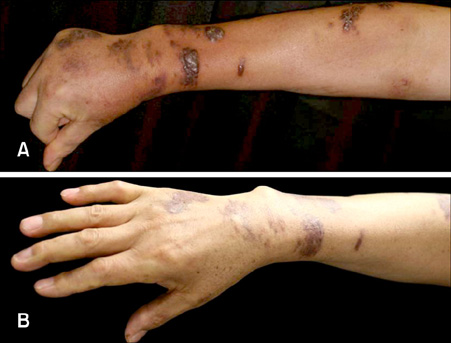Ann Dermatol.
2009 Aug;21(3):297-299. 10.5021/ad.2009.21.3.297.
Kaposi Sarcoma after Corticosteroid Therapy for Idiopathic Thrombocytopenic Purpura
- Affiliations
-
- 1Department of Dermatology, College of Medicine, The Catholic University of Korea, Seoul, Korea. hjpark @catholic.ac.kr
- 2Department of Oncology, College of Medicine, The Catholic University of Korea, Seoul, Korea.
- KMID: 2266296
- DOI: http://doi.org/10.5021/ad.2009.21.3.297
Abstract
- Kaposi sarcoma (KS) is a multifocal vascular neoplasm most commonly seen in association with human immunodeficiency virus infection. However, KS has also been reported in patients treated with immunosuppressive agents. However, it is very rare to find KS in association with idiopathic thrombocytopenic purpura (ITP). Here we describe a 58-year-old male patient suffering from ITP treated with corticosteroid therapy who developed KS and present a review of the literature.
MeSH Terms
Figure
Reference
-
1. Penn I. Kaposi's sarcoma in organ transplant recipients: report of 20 cases. Transplantation. 1979. 27:8–11.
Article2. Vincent T, Moss K, Colaco B, Venables PJ. Kaposi's sarcoma in two patients following low-dose corticosteroid treatment for rheumatological disease. Rheumatology (Oxford). 2000. 39:1294–1296.
Article3. Casoli P, Tumiati B. Rheumatoid arthritis, corticosteroid therapy and Kaposi's sarcoma: a coincidence? A case and review of literature. Clin Rheumatol. 1992. 11:432–435.
Article4. Casoli P, Tumiati B. Kaposi's sarcoma, rheumatoid arthritis and immunosuppressive and/or corticosteroid therapy. J Rheumatol. 1992. 19:1316–1317.5. Trattner A, Hodak E, David M, Sandbank M. The appearance of Kaposi sarcoma during corticosteroid therapy. Cancer. 1993. 72:1779–1783.
Article6. Bloom E, Matulich DT, Lan NC, Higgins SJ, Simons SS, Baxter JD. Nuclear binding of glucocorticoid receptors: relations between cytosol binding, activation and the biological response. J Steroid Biochem. 1980. 12:175–184.
Article7. Gascoyne DM, Kypta RM, Vivanco MM. Glucocorticoids inhibit apoptosis during fibrosarcoma development by transcriptionally activating Bcl-xL. J Biol Chem. 2003. 278:18022–18029.
Article8. Wijermans PW, van Groningen K, van Royen EA, Bruijn JA. Kaposi's sarcoma in an HIV-negative CLL patient as the cause of thrombocytopenia. Ann Hematol. 1994. 68:307–310.
Article9. Turnbull A, Almeyda J. Idiopathic thrombocytopenic purpura and Kaposi's sarcoma. Proc R Soc Med. 1970. 63:603–605.
Article10. Kohno M, Miyata M, Ohmoto A, Matsuyama R. Kaposi's sarcoma developing during corticosteroid therapy in idiopathic thrombocytopenic purpura. Rinsho Ketsueki. 1989. 30:1310–1313.11. Toyohama T, Nagasaki A, Miyagi J, Takamine W, Sunagawa K, Uezato H, et al. Kaposi's sarcoma in a human immunodeficiency virus-negative patient treated with corticosteroid for idiopathic thrombocytopenic purpura. Intern Med. 2003. 42:448–449.
Article
- Full Text Links
- Actions
-
Cited
- CITED
-
- Close
- Share
- Similar articles
-
- Kaposi Sarcoma Developed During Corticosteroid Therapy in Patient with Idiopathic Thrombocytopenic Purpura
- A case of idiopathic thrombocytopenic purpura in pregnancy
- Diagnosis and treatment of purpura
- Idiopathic Thrombocytopenic Purpura
- A Case of Systemic Lupus Erythematous (SLE) with Graves' Desease and Idiopathic Thrombocytopenic Purpura (ITP)



